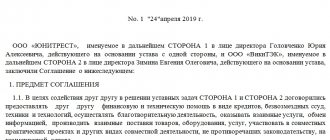Each Order issued at the enterprise is subject to registration and assignment of a personal number. This is necessary to eliminate attempts to formalize administrative decisions “retrospectively”. Since registration must take place sequentially, each company must have a Journal of Orders that allows control of the organization’s document flow.
- Why do you need a personnel order log?
- What documents are included in the journal?
- Journal structure
- How to lead correctly
- How and for how long to store the journal
Why do you need a personnel order log?
According to personnel theory, such a Journal can be used not only to register Orders, but also to enter information about all orders relating to employed employees.
The expediency of using the Book of Orders is due to the following reasons:
- the storage period for documentation is 75 years and such a Book serves as a good archival indicator of where and how to find the necessary administrative document;
- Most types of Orders require mandatory registration, so in any case there must be a Journal for entering information about such administrative documents.
In some enterprises, there is a rule according to which administrative documents (or other documents drawn up by employees) acquire legal force only after the registration procedure. Registration, in this case, is a record of a disposition/order (letter, summons, report) that confirms its execution and sending to the addressee, if necessary. The company can independently determine how and where to register documents, but as a general rule, it is most convenient to keep a separate journal for each type of correspondence.
In this regard, drawing up the Book of Orders is an obligation. And without this step (without registration of the administrative document), it will not be able to obtain legal force, which means its execution will be optional for the participants in legal relations.
Nuances
It is necessary to avoid correcting entries in the journal (erasures, additions, deletions), this may be recognized as a mistake, which leads to the closure of the case. To avoid complaints from inspectors and not close the case, do the simple thing: rewrite the log without errors.
If there is a need to make an entry retroactively , for example, if the order number was reserved, but its details are not indicated in the journal, and another order was issued under this number, you can do this:
- print or create a new journal form by copying the title page;
- rewrite lines to the desired number;
- enter information about the “forgotten” order, assigning it a serial number with a fraction (for example, number 13 will be followed by 13/1);
- continue recording from the next issue (according to the old journal).
Do not forget to put the order with a fractional number in the folder, observing the chronology.
Advice: Inspectors do not have to provide the original journal ; a certified copy is sufficient. However, the court may also require the original.
What documents are taken into account in the journal: specifics of orders for personnel
There are several types of Orders regulating different types of labor relations. On the other hand, the legislation provides for two forms of agreement:
- – an administrative document that concerns only one employee of the enterprise;
- T1a – An order issued in relation to several employees at once, if it is necessary to regulate one type of legal relationship (reward, punishment, vacation).
According to legal theory, it is customary to include only those administrative documents that apply to ordinary employees (not related to management in accordance with the charter) as personnel orders. For example, an order for the appointment of a general director or chief accountant should not be registered in the Book of Orders.
In this regard, labor practice allows us to identify the following types of administrative documents that are subject to registration in the Journal and which, without registration, will not receive legal force:
- employment (hiring for a permanent job, part-time and part-time work, remote and part-time work, fixed-term and indefinite legal relationships);
- termination of work (regardless of the grounds for dismissal);
- moving between positions;
- employee combination;
- part-time employment (internal and external) of the employee;
- the procedure for receiving wages (additional bonuses and financial penalties);
- business trip assignment;
- registration of leave (regular, extracurricular, at your own expense, for study, for personal reasons).
Each type of order has its own Order form code, but these are advisory forms. Participants in legal relations can independently draw up an Order that corresponds to the specifics of the proceedings and the stated goals.
Registration of the Order is carried out by an employee of the HR department, who is obliged to control the circulation of administrative documents within the enterprise. And, before proceeding with registration, you should make sure that the document meets the established requirements. In particular, you need to pay attention to the following factors:
- indication of the legal basis for the preparation of the administrative document (employment is carried out on the basis of a signed work contract, leave is issued in accordance with the accepted schedule, study leave is based on a call from the educational institution);
- indication of the required details of the document (name, date, number, place of drawing up the order)
- entering the main content, which includes the detailed circumstances of the execution of the administrative document and its consequences for the participants;
- the document ends with the signature of the employer represented by the director;
- affixing the company seal;
- the presence of a section on the approval of the document by a lawyer or other competent employee.
Logbook for registering orders for personnel: document structure
As noted above, the legislation does not establish a single form of the document, therefore each enterprise develops its own convenient form, applicable in current production conditions . Columns are entered into the Journal that allow you to quickly find the required document and make it possible to control their circulation.
As practice shows, most often the Book consists of the following parts:
- title;
- list of persons responsible for maintaining the Book;
- the main section containing columns where information about the administrative document is entered.
Title
The title page of the document contains the following information:
- full name of the company (without abbreviations or abbreviations);
- the name of the Book “Journal of registration of orders”;
- date of creation of the report notebook;
- end date of maintenance (will be entered when the sheets in the Journal run out).
List of responsible employees
The appointment of a responsible person occurs through the preparation by the head of the relevant Order. If the employee agrees with the powers entrusted to him, then he signs the administrative document. And only after this information about the employee will be added to the Journal.
So, on the second page of the document the following data should be displayed:
- last name, first name, patronymic, position of the responsible employee (there may be several);
- details of the Order of the employer who appointed the responsible person;
- signature of the responsible employee confirming the beginning of the execution of entrusted powers.
Main section
All pages of the book are numbered and stitched. This is done to preserve information about the administrative documents drawn up. There are no uniform requirements for what data should be entered in this section. But, as practice shows, the most necessary graphs will be the following:
- serial number of the signed document;
- date of signing and registration of the Order;
- type of administrative document (on leave, on hiring, on dismissal, on imposing a penalty/incentive);
- a list of employees affected by the Order;
- a normative act on the basis of which an administrative document has been prepared (call from the place of study, vacation schedule).
Responsibilities
Each company that issues orders for its core activities (and there is no way to do without them) is required to keep a log of orders for its core activities. This was stated at the very beginning (in part A of article 258) of the List of archival documents, which was adopted by Order of the Ministry of Culture No. 558 of August 25, 2010.
However, this is only an indirect indication. There is no direct order or instruction in this regard. But during inspections by regulatory authorities, it is better to present logs of this type. In addition, its presence:
- Allows you to prove the very existence of a particular order. This feature greatly simplifies life in the event of litigation. The very fact of the existence of a record indicates the existence of the document.
- Allows you to navigate through orders for your main activities, quickly find and refer to what you need.
- Significantly simplifies the document flow of the organization as a whole and allows you to classify orders.
Maintaining a log book
As noted above, the Journal of Orders refers to optional reports, that is, their availability at the enterprise is determined only by the requirement of the manager and the responsibility of the personnel employee. As for the procedure for maintaining a notebook, one should be guided by universal rules, which provide that all administrative documents are entered into the Book in chronological order.
This means that not only the serial numbers in the Journal are strictly observed, but also the numbers assigned to the Orders and the dates of their execution. All information must be consistent.
Additionally, a local code can be used to divide administrative documents into categories. Thanks to this letter and number designation, it will be easier to search for orders for further familiarization with them.
If abbreviations are used in the content of the Journal, then their explanation should be presented on a separate page after information about the responsible employees and before the main body of the Book.
An example of using a letter cipher:
- B – in relation to administrative documents containing information on rewards and disciplinary punishments;
- K - related to personnel movements (hiring, dismissal, combination);
- KM – travel arrangements;
- LS – administrative documents for personnel;
- О – provision of any type of leave.
Thus, the personnel employee who controls administrative documentation is authorized to independently regulate the procedure for monitoring issued and registered orders. Throughout the entire period of use, the personnel officer can change the form of the Journal, adding/deleting columns in order to improve reporting.
As noted above, all pages of the document are subject to mandatory numbering . Tearing out sheets is strictly prohibited. In addition, you should be extremely careful when entering information. Errors, corrections and blots are not allowed. The use of corrector is strictly prohibited. If there is a need to correct information, the personnel employee crosses out the false text and writes the correct information next to it. Then, next to the correction, the signature of the responsible employee and the date the amendments were made are placed.
Maintaining a journal in electronic form
At some enterprises, reporting is done electronically. To do this, use a regular text document with a self-designed table, or use special personnel reporting programs.
Regardless of which method is chosen, you will have to regularly (as you fill out the electronic sheets) print out the report, number the pages and stitch them into a single document. This way you can protect your reports from computer system failure.
Responsible for maintaining
There are no uniform requirements for who should keep the Book of Orders. As practice shows, most often this is a personnel employee. The person in charge may also be the company’s lawyer or the manager’s secretary. In fact, this is any person in the company who controls the document flow and who has given his consent to expand his functional responsibilities.
Is it possible to keep an electronic journal?
This journal can be kept electronically. However, there are nuances here:
- If there are paper and electronic versions of paper and there are discrepancies in them, then preference is given to the printed version. These are the unspoken rules of the inspections carried out.
- The electronic version may not always be available for use. This is due to updates, computer viruses, and freezes. All these disadvantages of technology appear at the most inopportune moment. So you must have a paper version for insurance purposes. There are cases when, when updating a particular program, the previously entered information is completely lost.
Of course, in case of errors, blots, or typos, the journal of orders for the main activity will have to be reprinted and re-certified with signatures.
If after closing the journal (at the end of the year) there are empty lines in the printed form, they must be crossed out. At the end, the number of completed sheets is written down by hand.
How and for how long to store the journal
The current Journal is maintained until the free pages run out. After this, the Book is subject to transfer to the archive, where it will remain for a specified period of time. As a general rule, the minimum retention period for documentation is three years. If we are talking about Orders regarding personnel, then they must be in the archives for 75 years. On average, the storage period for documents varies within 25 years.
At the end of the established period of storage of the Journal, it is transferred for destruction, about which a report is drawn up and signed by competent officials.
Application
Sample of filling out the log of orders for personnel










